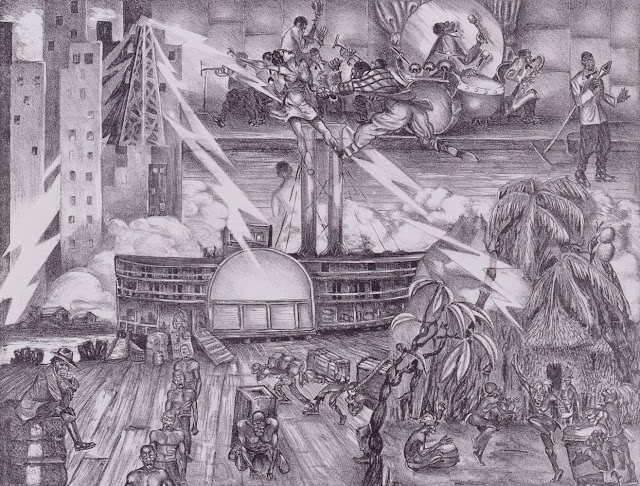Above: "Swingtime," an aquatint and etching by Charles L. Sallee, Jr. (1911-2006) created while he was in the WPA, ca. 1935-1943. Sallee was an African American artist and, according to the blog of the Sandusky Library (Ohio), he served in the Army Corps of Engineers during World War II (as a draftsman and cartographer, designing "roads and escape routes"), and then went on to enjoy "a long career as an interior designer." Image courtesy of the General Services Administration and the Kelvin Smith Library, Case Western Reserve University.
Above: "Jitterbug Swing," a color woodcut print by David Burke, created while he was in the WPA, ca. 1935-1943. I wasn't able to find much information on David Burke on the Internet or in newspaper archives but, interestingly, it seems that one of his woodcuts from the 1930s, quite possibly a New Deal artwork, is listed as stolen on the FBI's National Stolen Art File ("Fishing Port Landscape with View of Back Bay"). Image courtesy of the Metropolitan Museum of Art, used here for educational and non-commercial purposes.
Above: "Evolution of Swing," a lithograph by Raymond Steth (1917-1997), created while he was in the WPA, ca. 1939. This artwork highlights the origins of (or major influence on) swing dance: Africa and slavery. Image courtesy of the Smithsonian American Art Museum.
Above: A WPA poster, advertising the WPA dance production Swing Parade. Swing Parade was performed in San Francisco from April 15 through June 30, 1937 (Hallie Flanagan, Arena, 1940, p. 391). Image courtesy of the Library of Congress.
Above: A WPA poster, advertising the WPA dance production Swing Mikado. Swing Mikado was a very popular federal theatre production and played in several venues across the nation. In New York, it became so popular that some private sector Broadway producers became jealous and upset (see, Susan Quinn, Furious Improvisation, 2008, pp. 270-271). Image courtesy of the Library of Congress.





No comments:
Post a Comment